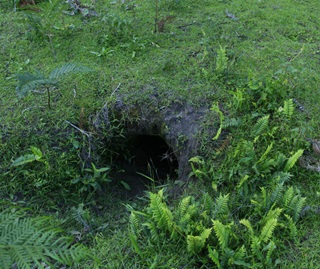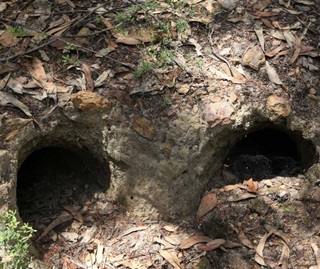 Many of the problems between wombats and people can be resolved by learning about the behaviour of wombats and understanding their habitats and needs.
Many of the problems between wombats and people can be resolved by learning about the behaviour of wombats and understanding their habitats and needs.
The bare-nosed wombat (Vombatus ursinus) is the species most frequently found in New South Wales. They prefer temperate forested areas of the coast, ranges and western slopes. Slopes above creeks and gullies are favoured sites for burrows and they like to feed in grassy clearings, including farm paddocks.
Bare-nosed wombat were once widespread from south-eastern Queensland, through New South Wales along the Great Dividing Range and most of Victoria. Their distribution in New South Wales is now fragmented and they are most abundant in the south-eastern parts of the state.
Remaining populations are under continued pressure from land clearing, road mortality, disease and illegal shooting. These pressures may be acute for some local populations.


 Wombats construct burrows to escape the heat and hide from predators. They prefer areas where it is easy for them to dig. The burrows can be up to 30 metres long and several metres deep and are usually situated above creeks and gullies and may have multiple entrances.
Wombats construct burrows to escape the heat and hide from predators. They prefer areas where it is easy for them to dig. The burrows can be up to 30 metres long and several metres deep and are usually situated above creeks and gullies and may have multiple entrances.  Wombats are mostly solitary animals, but overlapping home ranges can occasionally result in a number of wombats using the same burrow. Wombats are possessive about their particular feeding grounds and they will mark out these areas by leaving scent trails and droppings. These markings are prominently placed on rocks and logs around the boundaries. If an intruding wombat encroaches on another’s territory it will be discouraged through a series of snorts and screeches and at times physical aggression.
Wombats are mostly solitary animals, but overlapping home ranges can occasionally result in a number of wombats using the same burrow. Wombats are possessive about their particular feeding grounds and they will mark out these areas by leaving scent trails and droppings. These markings are prominently placed on rocks and logs around the boundaries. If an intruding wombat encroaches on another’s territory it will be discouraged through a series of snorts and screeches and at times physical aggression.
 Only inactive burrows may be bulldozed. Bulldozing an active burrow can lead to wombats being buried alive and suffering a slow and painful death.
Only inactive burrows may be bulldozed. Bulldozing an active burrow can lead to wombats being buried alive and suffering a slow and painful death.